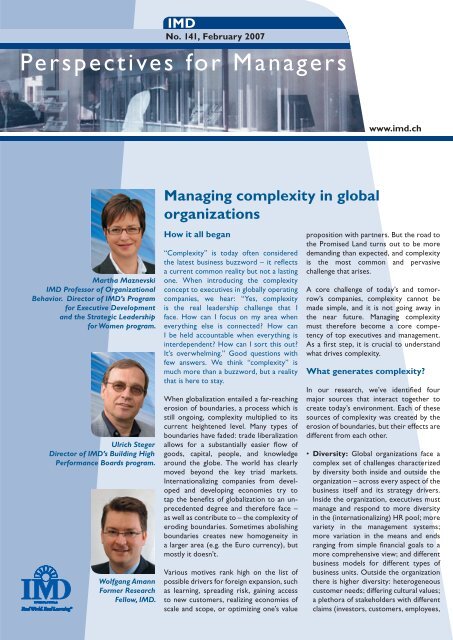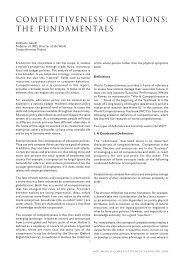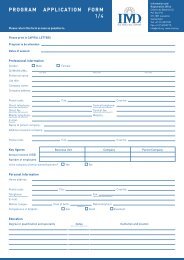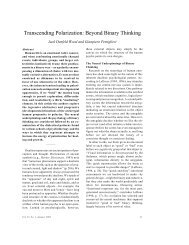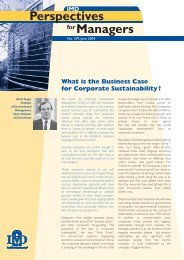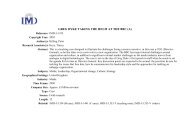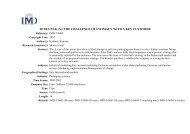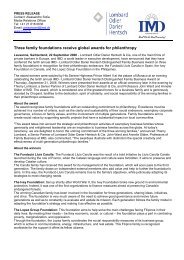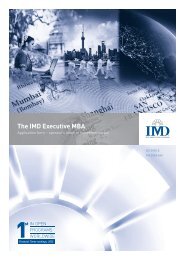Managing complexity in global organizations - FT.com
Managing complexity in global organizations - FT.com
Managing complexity in global organizations - FT.com
Create successful ePaper yourself
Turn your PDF publications into a flip-book with our unique Google optimized e-Paper software.
No. 141, February 2007<br />
<strong>Manag<strong>in</strong>g</strong> <strong><strong>com</strong>plexity</strong> <strong>in</strong> <strong>global</strong><br />
<strong>organizations</strong><br />
Martha Maznevski<br />
IMD Professor of Organizational<br />
Behavior. Director of IMD’s Program<br />
for Executive Development<br />
and the Strategic Leadership<br />
for Women program.<br />
Ulrich Steger<br />
Director of IMD’s Build<strong>in</strong>g High<br />
Performance Boards program.<br />
Wolfgang Amann<br />
Former Research<br />
Fellow, IMD.<br />
How it all began<br />
“Complexity” is today often considered<br />
the latest bus<strong>in</strong>ess buzzword – it reflects<br />
a current <strong>com</strong>mon reality but not a last<strong>in</strong>g<br />
one. When <strong>in</strong>troduc<strong>in</strong>g the <strong><strong>com</strong>plexity</strong><br />
concept to executives <strong>in</strong> <strong>global</strong>ly operat<strong>in</strong>g<br />
<strong>com</strong>panies, we hear: “Yes, <strong><strong>com</strong>plexity</strong><br />
is the real leadership challenge that I<br />
face. How can I focus on my area when<br />
everyth<strong>in</strong>g else is connected? How can<br />
I be held accountable when everyth<strong>in</strong>g is<br />
<strong>in</strong>terdependent? How can I sort this out?<br />
It’s overwhelm<strong>in</strong>g.” Good questions with<br />
few answers. We th<strong>in</strong>k “<strong><strong>com</strong>plexity</strong>” is<br />
much more than a buzzword, but a reality<br />
that is here to stay.<br />
When <strong>global</strong>ization entailed a far-reach<strong>in</strong>g<br />
erosion of boundaries, a process which is<br />
still ongo<strong>in</strong>g, <strong><strong>com</strong>plexity</strong> multiplied to its<br />
current heightened level. Many types of<br />
boundaries have faded: trade liberalization<br />
allows for a substantially easier flow of<br />
goods, capital, people, and knowledge<br />
around the globe. The world has clearly<br />
moved beyond the key triad markets.<br />
Internationaliz<strong>in</strong>g <strong>com</strong>panies from developed<br />
and develop<strong>in</strong>g economies try to<br />
tap the benefits of <strong>global</strong>ization to an unprecedented<br />
degree and therefore face –<br />
as well as contribute to – the <strong><strong>com</strong>plexity</strong> of<br />
erod<strong>in</strong>g boundaries. Sometimes abolish<strong>in</strong>g<br />
boundaries creates new homogeneity <strong>in</strong><br />
a larger area (e.g. the Euro currency), but<br />
mostly it doesn’t.<br />
Various motives rank high on the list of<br />
possible drivers for foreign expansion, such<br />
as learn<strong>in</strong>g, spread<strong>in</strong>g risk, ga<strong>in</strong><strong>in</strong>g access<br />
to new customers, realiz<strong>in</strong>g economies of<br />
scale and scope, or optimiz<strong>in</strong>g one’s value<br />
proposition with partners. But the road to<br />
the Promised Land turns out to be more<br />
demand<strong>in</strong>g than expected, and <strong><strong>com</strong>plexity</strong><br />
is the most <strong>com</strong>mon and pervasive<br />
challenge that arises.<br />
A core challenge of today’s and tomorrow’s<br />
<strong>com</strong>panies, <strong><strong>com</strong>plexity</strong> cannot be<br />
made simple, and it is not go<strong>in</strong>g away <strong>in</strong><br />
the near future. <strong>Manag<strong>in</strong>g</strong> <strong><strong>com</strong>plexity</strong><br />
must therefore be<strong>com</strong>e a core <strong>com</strong>petency<br />
of top executives and management.<br />
As a first step, it is crucial to understand<br />
what drives <strong><strong>com</strong>plexity</strong>.<br />
What generates <strong><strong>com</strong>plexity</strong>?<br />
In our research, we’ve identified four<br />
major sources that <strong>in</strong>teract together to<br />
create today’s environment. Each of these<br />
sources of <strong><strong>com</strong>plexity</strong> was created by the<br />
erosion of boundaries, but their effects are<br />
different from each other.<br />
• Diversity: Global <strong>organizations</strong> face a<br />
<strong>com</strong>plex set of challenges characterized<br />
by diversity both <strong>in</strong>side and outside the<br />
organization – across every aspect of the<br />
bus<strong>in</strong>ess itself and its strategy drivers.<br />
Inside the organization, executives must<br />
manage and respond to more diversity<br />
<strong>in</strong> the (<strong>in</strong>ternationaliz<strong>in</strong>g) HR pool; more<br />
variety <strong>in</strong> the management systems;<br />
more variation <strong>in</strong> the means and ends<br />
rang<strong>in</strong>g from simple f<strong>in</strong>ancial goals to a<br />
more <strong>com</strong>prehensive view; and different<br />
bus<strong>in</strong>ess models for different types of<br />
bus<strong>in</strong>ess units. Outside the organization<br />
there is higher diversity: heterogeneous<br />
customer needs; differ<strong>in</strong>g cultural values;<br />
a plethora of stakeholders with different<br />
claims (<strong>in</strong>vestors, customers, employees,
egulators etc.); various political, economic<br />
and legal environments; and<br />
f<strong>in</strong>ally, <strong>com</strong>petitors’ differ<strong>in</strong>g strategies.<br />
Most firms today <strong>in</strong>creas<strong>in</strong>gly face each<br />
of these types of diversity. <strong>Manag<strong>in</strong>g</strong><br />
the differences is not trivial, and<br />
reduc<strong>in</strong>g diversity often means be<strong>in</strong>g<br />
less responsive.<br />
• Interdependence: Companies must<br />
manage the effect of <strong>global</strong> <strong>in</strong>terdependence<br />
to an unprecedented degree:<br />
everyth<strong>in</strong>g is related to everyth<strong>in</strong>g else,<br />
and the impact is felt more rapidly and<br />
pervasively. Value webs have replaced<br />
traditional value cha<strong>in</strong>s. Reputation,<br />
f<strong>in</strong>ancial flows, value cha<strong>in</strong> flows, top<br />
management and corporate governance<br />
issues have reached advanced levels of<br />
<strong>in</strong>terdependence. The less clear-cut the<br />
boundaries of a <strong>com</strong>pany be<strong>com</strong>e, the<br />
more it is exposed to impacts on the<br />
value cha<strong>in</strong> flow through mistakes, frictions,<br />
reverse trends, or even shocks.<br />
Interdependence creates opportunities<br />
for <strong>global</strong>ization, but tak<strong>in</strong>g advantage<br />
of these opportunities raises<br />
difficult challenges.<br />
• Ambiguity: The bus<strong>in</strong>ess world today<br />
is characterized by too much <strong>in</strong>formation<br />
with less and less clarity on how to<br />
<strong>in</strong>terpret and apply <strong>in</strong>sights. A diversity<br />
of account<strong>in</strong>g standards renders f<strong>in</strong>ancial<br />
figures ambiguous. Studies, scenarios,<br />
survey results, and reports be<strong>com</strong>e<br />
less reliable due to an ever-<strong>in</strong>creas<strong>in</strong>g<br />
uncerta<strong>in</strong>ty. Many bus<strong>in</strong>esses f<strong>in</strong>d it<br />
more and more difficult to discover what<br />
their clear value drivers are. Are they<br />
image, price, related services, privileged<br />
relationships, speed, knowledge, or<br />
someth<strong>in</strong>g else? The cause-effect<br />
relationships be<strong>com</strong>e blurred.<br />
• Flux: As if these three <strong><strong>com</strong>plexity</strong> drivers<br />
were not enough, managers have to face<br />
yet another one, flux or change. Even<br />
if you figure out temporary solutions<br />
regard<strong>in</strong>g <strong>in</strong>terdependence, diversity<br />
and ambiguity for your specific <strong>com</strong>pany,<br />
<strong>in</strong>dustry, and personal situation, the<br />
situation can change the next day. Today’s<br />
solutions may be outdated tomorrow.<br />
What are the repercussions?<br />
Everyth<strong>in</strong>g is diverse, and noth<strong>in</strong>g is<br />
stable, everyth<strong>in</strong>g is <strong>in</strong> “fast flux”:<br />
<strong>in</strong>terdependence is flow<strong>in</strong>g <strong>in</strong> chang<strong>in</strong>g<br />
directions. The future is no longer the<br />
prolongation of the past – <strong>in</strong>dustry<br />
“breakpo<strong>in</strong>ts”, fundamentally alter<strong>in</strong>g the<br />
value proposition <strong>in</strong> <strong>in</strong>dustries, occur<br />
more rapidly. The variety of options could<br />
overwhelm traditional decision-mak<strong>in</strong>g,<br />
as <strong>in</strong>formation often lacks clarity and is<br />
ambiguous. Multiple <strong>in</strong>terpretations of<br />
the same facts are possible, depend<strong>in</strong>g on<br />
the perspective or cultural framework.<br />
Shared understand<strong>in</strong>g cannot be assumed<br />
per se, whether <strong>in</strong>side or outside the<br />
organization. Thus, <strong>in</strong>terdependence, diversity<br />
and ambiguity – all <strong>in</strong> flux – are<br />
the build<strong>in</strong>g blocks of managerial <strong><strong>com</strong>plexity</strong><br />
and expla<strong>in</strong> why <strong>global</strong> <strong>com</strong>panies<br />
have often been perceived as the most<br />
<strong>com</strong>plex <strong>organizations</strong>.<br />
Many people have tried to simplify <strong><strong>com</strong>plexity</strong>,<br />
and contemporary management<br />
literature is mislead<strong>in</strong>g when trumpet<strong>in</strong>g<br />
THE success factor. Studies typically<br />
exam<strong>in</strong>e successful <strong>com</strong>panies to see what<br />
managers “did”, then conclude that all<br />
managers should do the same th<strong>in</strong>g. As<br />
unpredictability makes us un<strong>com</strong>fortable,<br />
delusions are created about performance<br />
as voluntaristic matter of choice (<strong>com</strong>panies<br />
can choose “to be great”); we like<br />
the certa<strong>in</strong>ty promised by these solutions.<br />
But <strong>in</strong> an <strong>in</strong>terdependent world, much<br />
depends on cont<strong>in</strong>gencies, with no clear<br />
correction between <strong>in</strong>put and output.<br />
Accountability of managers has therefore<br />
an arbitrary element: yes, managers are<br />
responsible, but results are <strong>in</strong>fluenced by<br />
factors beyond their control. Navigat<strong>in</strong>g<br />
through this <strong><strong>com</strong>plexity</strong> requires a different<br />
way of th<strong>in</strong>k<strong>in</strong>g, act<strong>in</strong>g, and organiz<strong>in</strong>g than<br />
the typical “control” mentality.<br />
A long list of advantages lures <strong>com</strong>panies<br />
<strong>in</strong>to <strong>global</strong>iz<strong>in</strong>g. Geographic expansion<br />
abroad offers the vast potential benefits of<br />
a much larger market arena, spread risks,<br />
scope-, scale- and location-based cost<br />
advantages, and exposure to a variety of<br />
new product and process ideas.<br />
The practical consequence of <strong><strong>com</strong>plexity</strong> is<br />
that a managerial dilemma often shapes the<br />
decision-mak<strong>in</strong>g process when there are<br />
two or more conflict<strong>in</strong>g legitimate goals to<br />
meet demands. Both cannot be simultaneously<br />
achieved with the given resources.<br />
Companies <strong>in</strong> the f<strong>in</strong>ancial service <strong>in</strong>dustry<br />
set up <strong>com</strong>pet<strong>in</strong>g distribution channels,<br />
but expect far-reach<strong>in</strong>g cooperation<br />
across the <strong>com</strong>pany (shared services and<br />
product platforms) to reap economics<br />
of scale. In manufactur<strong>in</strong>g, one ongo<strong>in</strong>g<br />
dilemma is between <strong>global</strong> standardization<br />
and response to local market needs. Any<br />
required priority decision nevertheless<br />
results <strong>in</strong> ongo<strong>in</strong>g tension. As dilemmas<br />
cannot be solved, they need to be managed<br />
– cont<strong>in</strong>uously.<br />
Ways to cope<br />
Global <strong>com</strong>panies first reacted to this<br />
<strong>com</strong>plex bus<strong>in</strong>ess environment by creat<strong>in</strong>g<br />
<strong>com</strong>plex <strong>organizations</strong>. This was consistent<br />
with Ashby’s law of requisite variety, <strong>in</strong><br />
that the <strong><strong>com</strong>plexity</strong> of an organization<br />
<strong>in</strong>ternally must match the <strong><strong>com</strong>plexity</strong> of<br />
its external environment. We saw multiple<br />
axes of management: along product<br />
l<strong>in</strong>es, geography, customers, functions<br />
and projects. For example, ABB had a<br />
six-dimensional matrix structure (for a<br />
short time, at least, before they simplified<br />
the structure dramatically <strong>in</strong> their<br />
turnaround). The simple relation between<br />
headquarters as strategic decision-makers<br />
and subsidiaries as implementers is blurred<br />
by centers of excellence or <strong>com</strong>petence,<br />
market responsibilities, jo<strong>in</strong>t ventures, etc.<br />
But structures and policies alone are<br />
not the solution. The more <strong>com</strong>plex the<br />
structures and policies be<strong>com</strong>e, the more<br />
<strong>com</strong>plex they are to manage. Eventually<br />
the organization implodes upon itself,<br />
spend<strong>in</strong>g more time manag<strong>in</strong>g the <strong>in</strong>ternal<br />
<strong><strong>com</strong>plexity</strong> than <strong>in</strong>teract<strong>in</strong>g with the<br />
environment, where real value is created.<br />
Companies beg<strong>in</strong>n<strong>in</strong>g to grapple with<br />
<strong><strong>com</strong>plexity</strong> <strong>in</strong> effective ways <strong>in</strong>terpret<br />
Ashby’s law differently. They harness the<br />
<strong><strong>com</strong>plexity</strong> already <strong>in</strong>herent with<strong>in</strong> the
<strong>Manag<strong>in</strong>g</strong> <strong><strong>com</strong>plexity</strong> <strong>in</strong> <strong>global</strong> <strong>organizations</strong><br />
organization – people and relationships,<br />
and so on – to work for the <strong>com</strong>pany<br />
rather than aga<strong>in</strong>st it. They add Thoreau’s<br />
advice to the recipe: simplify, simplify! But<br />
they choose carefully what they simplify,<br />
without mak<strong>in</strong>g the organization or its<br />
processes too simple.<br />
In our book published <strong>in</strong> March 2007,<br />
<strong>Manag<strong>in</strong>g</strong> Complexity, we advise on<br />
focus<strong>in</strong>g on the professional quality of<br />
decision-mak<strong>in</strong>g. We encourage the<br />
simplification of organizational processes<br />
<strong>in</strong> specific ways, rather than predict<strong>in</strong>g the<br />
out<strong>com</strong>e and simplify<strong>in</strong>g one’s picture of the<br />
environment.<br />
Simplify a few key issues:<br />
Use <strong><strong>com</strong>plexity</strong> as an<br />
opportunity elsewhere<br />
We’ve identified four key issues around<br />
which <strong>com</strong>panies must simplify: purpose<br />
and values; core processes and decentralization;<br />
early awareness systems; and<br />
leadership. Once these are clear and<br />
consistent, managers <strong>in</strong> different areas of<br />
the <strong>com</strong>pany can respond to <strong><strong>com</strong>plexity</strong><br />
accord<strong>in</strong>g to their own needs and<br />
realities.<br />
Purpose and values<br />
The purpose, our reason for be<strong>in</strong>g <strong>in</strong> this<br />
bus<strong>in</strong>ess, provides a “guid<strong>in</strong>g star” on the<br />
horizon, a framework for prioritiz<strong>in</strong>g goals.<br />
Every bus<strong>in</strong>ess book talks about the importance<br />
of purpose and values, so perhaps<br />
this is noth<strong>in</strong>g new. However, <strong>in</strong> simple and<br />
stable environments, even if the vision is a<br />
wishy-washy vague statement, it can provide<br />
enough guidance for people to manage<br />
well. But, <strong>in</strong> a <strong>com</strong>plex environment,<br />
the guidance provided by a focused, even<br />
“discrim<strong>in</strong>at<strong>in</strong>g” statement of purpose and<br />
values – what NOT to do – is absolutely<br />
critical. Every manager <strong>in</strong> the <strong>com</strong>pany<br />
should understand clearly and deeply what<br />
really drives the bus<strong>in</strong>ess, the fundamentals<br />
of the bus<strong>in</strong>ess’s profitability, and why the<br />
<strong>com</strong>pany is <strong>in</strong> bus<strong>in</strong>ess. This might be difficult<br />
for a diversified multi-national, but at<br />
least has to be achieved at the level of a<br />
Division/Strategic Bus<strong>in</strong>ess Unit.<br />
Once this is understood it leads to the<br />
values, the bus<strong>in</strong>ess “shoulds and oughts”,<br />
to determ<strong>in</strong>e priorities <strong>in</strong> dilemmas, help<br />
focus actions and provide consistent<br />
patterns of behavior over time. Companies<br />
best at deal<strong>in</strong>g with <strong><strong>com</strong>plexity</strong> never<br />
have more than three or four core values,<br />
never to be <strong>com</strong>promised and therefore<br />
consistent with a <strong>com</strong>pell<strong>in</strong>g bus<strong>in</strong>ess logic.<br />
A longer “laundry list” of values is confus<strong>in</strong>g<br />
at best and provides rationale for any<br />
action at worst. At the same time, it is<br />
helpful to have a few “behavioral values”<br />
beyond the core that guide the “how” of<br />
the execution; behavioral values can be<br />
<strong>com</strong>promised, but must be expla<strong>in</strong>ed. A<br />
clearly def<strong>in</strong>ed and well accepted set of<br />
core values plus a guid<strong>in</strong>g set of behavioral<br />
values therefore allows diversity at<br />
the periphery, local empowerment for<br />
adaptation, learn<strong>in</strong>g and experimentation,<br />
the existence of additional values per<br />
region, unit, profession – as long as they do<br />
not contradict the core values.<br />
Core processes and<br />
decentralized authority<br />
Core processes are those used by the<br />
entire <strong>com</strong>pany. These vary from bus<strong>in</strong>ess<br />
to bus<strong>in</strong>ess, but most managers know<br />
what is vital. In a consult<strong>in</strong>g firm, core<br />
processes might be knowledge shar<strong>in</strong>g<br />
and recruit<strong>in</strong>g; <strong>in</strong> a heavy manufactur<strong>in</strong>g<br />
firm they might be capital budget<strong>in</strong>g and<br />
logistics; <strong>in</strong> a pharmaceuticals firm they<br />
might be research and development and<br />
go-to-market processes. A firm’s core<br />
processes should always be standardized<br />
(not necessarily centralized) and based<br />
on <strong>com</strong>prehensive, accessible <strong>in</strong>formation<br />
platforms. As this imposes cost, one has<br />
to be very clear what is needed as core.<br />
Such processes might change over time,<br />
and more often than the bus<strong>in</strong>ess model or<br />
the core values. It is therefore important<br />
to erase old processes when <strong>in</strong>troduc<strong>in</strong>g<br />
new ones. But only standardized processes<br />
generate the transparency key for accountability<br />
on levels further down the<br />
organization. With such transparency and<br />
accountability, therefore, decentralization<br />
is possible without the <strong>com</strong>pany break<strong>in</strong>g<br />
down <strong>in</strong>to political silos and bicker<strong>in</strong>g<br />
fiefdoms. With decentralization consistent<br />
with core processes, local managers can<br />
engage <strong><strong>com</strong>plexity</strong> <strong>in</strong> the way most effective<br />
for them.<br />
Unpredictable situations –<br />
an early awareness system<br />
Chaos is a degree of <strong><strong>com</strong>plexity</strong> <strong>in</strong> which<br />
few of the rules and drivers are understood.<br />
Compare it to a weather forecast<strong>in</strong>g<br />
system: never <strong>com</strong>pletely right, but rarely<br />
<strong>com</strong>pletely wrong. And early awareness<br />
doesn’t need sophisticated systems and<br />
much manpower. It is – more than anyth<strong>in</strong>g<br />
else – a m<strong>in</strong>dset, a sensitivity that allows<br />
“weak signals” that <strong>in</strong>dicate emerg<strong>in</strong>g<br />
change and foresight to be understood. To<br />
deal with <strong><strong>com</strong>plexity</strong>, identify the variables<br />
that create predictable out<strong>com</strong>es when<br />
they’re with<strong>in</strong> a particular range, and<br />
unpredictable out<strong>com</strong>es when they are<br />
not. As one executive recently told us,<br />
“We track hurricanes. As long as they stay<br />
outside of this range, we don’t pay much<br />
attention or put anyth<strong>in</strong>g <strong>in</strong>to action. But<br />
as soon as they hit <strong>in</strong>side this range, we<br />
start to put our cont<strong>in</strong>gency plans <strong>in</strong>to<br />
place.” When fac<strong>in</strong>g <strong><strong>com</strong>plexity</strong>, managers<br />
need to identify which “hurricanes” they<br />
need to track, and which levels or ranges<br />
should trigger cont<strong>in</strong>gency plans.<br />
Leadership<br />
Lead<strong>in</strong>g a <strong>com</strong>plex organization requires<br />
an entirely different m<strong>in</strong>dset. Hierarchy<br />
works if every level is do<strong>in</strong>g someth<strong>in</strong>g<br />
dist<strong>in</strong>ct and specific. However, due to<br />
the <strong>in</strong>terdependence <strong>in</strong> <strong><strong>com</strong>plexity</strong>, this<br />
is impossible <strong>in</strong> today’s <strong>organizations</strong>. By<br />
simplify<strong>in</strong>g and clarify<strong>in</strong>g vision and values,<br />
core processes and decentralization, and<br />
early awareness systems, hierarchy can<br />
be <strong>com</strong>plemented by “heterarchy”, the<br />
<strong>in</strong>terdependent, networked organization<br />
<strong>in</strong> which every part reflects a different<br />
perspective of the whole and which is<br />
needed <strong>in</strong> today’s <strong>global</strong> bus<strong>in</strong>ess world.<br />
The boss no longer needs to “tell” the<br />
team members what exactly to do, but<br />
rather depend on their <strong>in</strong>itiative, creativity<br />
and <strong>com</strong>petence for success. Leadership<br />
<strong>in</strong> a networked organization means not
only provid<strong>in</strong>g different leadership roles<br />
and styles depend<strong>in</strong>g on the situation (but<br />
always consistent with the purpose, values,<br />
and core processes), but also lead<strong>in</strong>g<br />
different parts of a networked organization<br />
to work together to create value.<br />
The leader of a <strong>com</strong>plex organization must<br />
create and <strong>com</strong>municate understand<strong>in</strong>g<br />
of the different roles managers, teams,<br />
bus<strong>in</strong>ess units, and bosses play <strong>in</strong> the<br />
<strong>in</strong>ter-dependent structure, otherwise<br />
confusion is <strong>in</strong>tensified. Leadership cannot<br />
be repetitive, but should be predictable.<br />
Permanent <strong>com</strong>munication is therefore<br />
the leadership survival tool <strong>in</strong> <strong>com</strong>plex<br />
<strong>organizations</strong>, but much more <strong>in</strong> terms<br />
of “storytell<strong>in</strong>g”, <strong>in</strong>terpret<strong>in</strong>g context and<br />
mean<strong>in</strong>g, and <strong>in</strong>vest<strong>in</strong>g <strong>in</strong> relationships than<br />
<strong>in</strong> transferr<strong>in</strong>g dry facts or ultimatums.<br />
Master<strong>in</strong>g <strong>global</strong> <strong><strong>com</strong>plexity</strong><br />
We have not yet <strong>com</strong>e across a <strong>com</strong>pany<br />
hav<strong>in</strong>g mastered <strong>global</strong> <strong><strong>com</strong>plexity</strong><br />
– perhaps there are none, perhaps there<br />
never will be any! However, various<br />
sections of “<strong>Manag<strong>in</strong>g</strong> Complexity” po<strong>in</strong>t<br />
to several <strong>global</strong> <strong>com</strong>panies highlight<strong>in</strong>g<br />
various aspects of manag<strong>in</strong>g <strong><strong>com</strong>plexity</strong>,<br />
or the effects of not manag<strong>in</strong>g it well.<br />
The decade-long difficulties of General<br />
Motors (GM) – and to a lesser degree<br />
Ford – clearly have their roots <strong>in</strong> the long<br />
traditional control mode, lead<strong>in</strong>g to GM’s<br />
vast bureaucracy and a typical out<strong>com</strong>e:<br />
mediocre products due to risk aversion,<br />
mistrust of management (reflected <strong>in</strong><br />
the high degree of unionization), high<br />
transaction costs and slow response.<br />
the world. (The famous notion that every<br />
eng<strong>in</strong>eer at Toyota can work <strong>in</strong> every<br />
Toyota factory of the world without hav<strong>in</strong>g<br />
adaptation problems, is probably slightly<br />
exaggerated, but only slightly…).<br />
A similar set of elements are found <strong>in</strong><br />
other <strong>global</strong> <strong>com</strong>panies: family bus<strong>in</strong>esses,<br />
a luxury goods bus<strong>in</strong>ess (due to the<br />
identification with the product) or Dupont,<br />
known for strong values on safety. R&D<br />
driven <strong>in</strong>dustries, such as the pharmaceutical<br />
<strong>in</strong>dustry, are known for focused bus<strong>in</strong>ess<br />
models (if they have not over<strong>com</strong>pensated<br />
this by seize-through mergers). Energy<br />
<strong>com</strong>panies, especially Exxon Mobile, are<br />
driven by standardized <strong>global</strong> processes,<br />
whereas fast-mov<strong>in</strong>g custom goods and<br />
the food <strong>in</strong>dustry are known for strong<br />
regional decentralization, but bound<br />
together they have shared processes across<br />
bus<strong>in</strong>ess l<strong>in</strong>es. Although no <strong>com</strong>pany may<br />
ever master <strong><strong>com</strong>plexity</strong> <strong>com</strong>pletely, it is<br />
possible, us<strong>in</strong>g these pr<strong>in</strong>ciples, to at least<br />
navigate through <strong><strong>com</strong>plexity</strong> and even to<br />
take advantage of it.<br />
IMD<br />
P. O. Box 915, CH 1001 Lausanne,<br />
Switzerland<br />
Tel.: +41 21 618 0111<br />
Fax: +41 21 618 0707<br />
<strong>in</strong>fo@imd.ch<br />
http://www.imd.ch<br />
© IMD, February 2007. No part of this publication<br />
may be reproduced without written authorization.<br />
An opposite example is Toyota, with a very<br />
clear value set (which is now challenged<br />
as it be<strong>com</strong>es a truly <strong>global</strong> <strong>com</strong>pany), a<br />
simpler model of core bus<strong>in</strong>ess processes<br />
and standardized processes throughout


